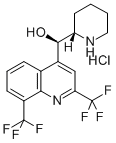Description
Mefloquine hydrochloride is an erythrocytic schizonticide useful, in combination
with sulfadoxine and pyrimethamine, in the prophylaxis and treatment of malaria.
Administered once weekly, the combination is effective against pathogens
resistant to other agents.
Description
Mefloquine is an orally bioavailable quinolinemethanol derivative with antimalarial properties. It increases mean survival time and abolishes malarial infection in mice at doses of 10 and 40 mg/kg, respectively. It inhibits hemozoin formation, leading to an increase in free heme in purified trophozoites. It acts as an antagonist at the adenosine A
2A receptor, an agonist at serotonin 5-HT
2A and 5-HT
2C receptors, and has various effects on calcium homeostasis. Mefloquine increases the time mice spend in the light side of the light-dark box test and reduces immobility time in the tail suspension test, parameters typically associated with anxiolytic and antidepressant-like behavior. Formulations containing mefloquine have been used to prevent and treat malaria but have been associated with neuropsychiatric disturbances.
Chemical Properties
White Solid
Originator
Walter Reed (USA)
Uses
Antimalarial;Heme polymerase inhibitor
Uses
Mefloquine Hydrochloride (Polymorph Form E) is a polymorphic form of Mefloquine Hydrochloride (M207055), a quinoline methanol antimalarial agent.
Definition
ChEBI: Mefloquine hydrochloride is a hydrochloride.
General Description
Certified pharmaceutical secondary standards for application in quality control provide pharma laboratories and manufacturers with a convenient and cost-effective alternative to pharmacopeia primary standards
Biochem/physiol Actions
Blocker of gap junction channels Cx36 and Cx50.
Clinical Use
The newest of the 4-aminoquinolines,mefloquine, is marketed as the R,S-isomer. It was developedin the 1960s as part of the U.S. Army’s WalterReed Institute for Medical Research antimalarial researchprogram. It differs significantly from the other agents in this class by having two trifluromethyl moieties at positions2’ and 8' and no electronegative substituents at eitherpositions 6' (quinine) or 7' (chloroquine). Mefloquine alsodiffers from chloroquine and its analogs by being a schizonticide acting before the parasite canenter the erythrocyte. There is some evidence that it acts byraising the pH in the parasite’s vesicles interfering with itsability to process heme. Mefloquine-resistant strains ofP. falciparum have appeared. Relapse can occur with acuteP. vivax that has been treated with mefloquine because thedrug does not eliminate the hepatic phase of this species,which can reinfect the liver.
Mefloquine is teratogenic in rats, mice, and rabbits. Thereis an FDA-required warning that this drug can cause exacerbatemental disorders and is contraindicated in patients withactive depression, a recent history of depression, generalizedanxiety disorder, psychosis, schizophrenia, and other majorpsychiatric disorders or a history of convulsions.




